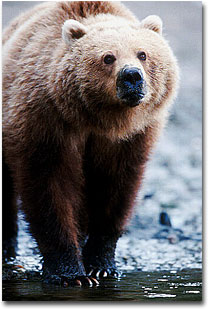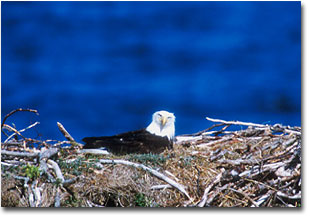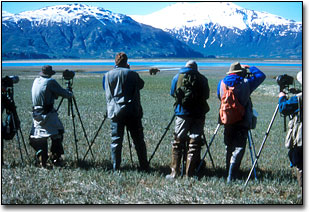|
The Camera Hunter®
Photography and Text Copyright Bill Silliker, Jr.
All rights reserved.
Waltzing with Bears
 "There are bears on the left, and bears on the right, and this one's looking at me like I'm dinner for tonight…" That's how songwriter/singer/wildlife photographer friend Jasper James described the brown bears of Alaska in the tune "Bears on the Left" on his CD "Beyond The Great Land". I couldn't help but think of those words as I stood on a Katmai beach one early morning, surrounded by bears.
"There are bears on the left, and bears on the right, and this one's looking at me like I'm dinner for tonight…" That's how songwriter/singer/wildlife photographer friend Jasper James described the brown bears of Alaska in the tune "Bears on the Left" on his CD "Beyond The Great Land". I couldn't help but think of those words as I stood on a Katmai beach one early morning, surrounded by bears.
When you say Katmai, folks usually think of Brooks Falls. The platforms there or at McNeil River comprise the near-bear experience most have had in Alaska. However, this up close and personal meeting with the bears was at a totally different setting. While others have photographed there, the serious photographers spending any significant time exploring the beaches and shoreline of the many nooks and crannies along Katmai's extensive coastline are few compared to the number that have shot at the other places where man can meet bear in peace.
Fellow full time pro Michael Francis and I were photography leaders for this trip with Coastal Outfitters, Anchor Point, Alaska. Working with Coastal Outfitters proved to be a wonderful experience on all counts. Simply stated, Chuck Keim, Coastal Outfitter's owner and captain, is one of the most bear aware people I've ever met. Because of that, working with him, his mate and equally experienced bear guide John Trautner exceeded all expectations for bears encountered, opportunities working with the bears and - bottom line for either the working pro or serious amateur - rolls of film shot. Your correspondent came home with 262 rolls from the 12-day shoot! Mike Francis beat my take by a handful of rolls.
The size of Chuck's boat, a refitted motorized yacht, limited the size of our group to 6 additional photographers. Mike and I were very selective when choosing the 6 participants. When you work with bears unarmed close range with no weapons, you need people who will follow directions and work as a team. No heroes were desired for this expedition. Our group included a former NANPA scholarship student and his mentor, plus several others we had shot with in the past.
This trip also wasn't for the faint of heart or anyone who doesn't know how to use their camera. We worked bears below the tide line at frame filling distances with a 500mm lens. Mostly they were feeding on clams and mussels along the shore. One pair mated before us, then sparred with each other in a post nuptial spat.
 In addition to photographing the bears, we shot a lot of bald eagles. Several great nest locations presented wonderful eagle opportunities. It's one of the reasons why I am leading another tour to coincide with bald eagle chick rearing season for June 2002. A look at the angle down to the eagle on the nest in the photo accompanying this article will tell you why.
In addition to photographing the bears, we shot a lot of bald eagles. Several great nest locations presented wonderful eagle opportunities. It's one of the reasons why I am leading another tour to coincide with bald eagle chick rearing season for June 2002. A look at the angle down to the eagle on the nest in the photo accompanying this article will tell you why.
For those who have conjectured that the Nikon 80-400 VR lens isn't worth owning, I'll just say that I shot about 40% of this shoot with one. I'm not paid by Nikon to say that. Sure, the lens is slow at AF. For approaching bears in a boat with the motor going, or to crop to capture the scene when you can't move away from the bears while on land, it's the right tool for the job. I'm sure that a handheld Canon IS telephoto would have worked just as well.
As for working with these bears, all of the tools of the camera hunter are required for such a shoot. Knowing bears: their behavior, body language, signs of aggression, warning signals, habits, when they might look up from clamming - all are needed to get the most effective shots with relative safety. The only real defense in this type of shooting is that knowledge and the teamwork of the group. Nobody gets out in front and nobody runs. There can be no food in the presence of the bears. You must stay together as a tight group, arms-length apart from each other. The gaggle of arms and legs made by that gang of people presents a more intimidating subject for a curious bear.
One of our group found out how that works when he experienced a momentary lapse of judgement and paused for a few more shots when the rest of the group moved. This cut him off from the group by about 50 feet - providing enough space for a curious bear to seize the opportunity to approach him for a closer look.
We told him to stand his ground, stand tall and avoid eye contact. That worked, but I guarantee you that our photographer friend didn't enjoy the up close and personal experience of having a big brown bear check him out thoroughly from ten feet away!
As for protection, John, Chuck, Mike and I carried "bear spray"- red pepper in an aerosol can specifically designed to stop an attack by these at times quite capable predators. Bear spray can work, according to tests done on a variety of bears, and from reports of over 60 people who have successfully sprayed a bear to stop its aggressive behavior and lived to tell about it. If you opt to carry spray for bears, learn how to use it. Don't let the pepper spray lull you into a false sense of security, so that you take foolish risks around any bear. Those who go into bear country should never let the can of spray on their belt give them the idea that they can do dumb things and survive.
 Learn all you can about bears first. Most close encounters do not require the use of spray. The four people in our group carrying bear spray were all quite experienced at working with bears for years in the field. Mike Francis actually had to use bear spray once, during a sudden encounter with a grizzly sow that charged to protect her cubs in a much too close accidental meeting while photographing elk in Canada. The rest of us hope we never have to use it.
Learn all you can about bears first. Most close encounters do not require the use of spray. The four people in our group carrying bear spray were all quite experienced at working with bears for years in the field. Mike Francis actually had to use bear spray once, during a sudden encounter with a grizzly sow that charged to protect her cubs in a much too close accidental meeting while photographing elk in Canada. The rest of us hope we never have to use it.
Had our photographer friend who had the uncomfortable close encounter described above been carrying bear spray, would he have used it? Only he can answer that question. But that could have been a big mistake. The bear was curious about him only, made no aggressive stance and displayed no warning body language. Who knows? Spraying it might have triggered an attack in defense, especially if done ineptly. And it would surely have been unfair to the bear.
Would you have sprayed that bear? Think about that one before you step into bear country for your next camera hunt.
And as always, catch yours in the good light.
BS-NPN 012
Comments on Bill Silliker, Jr.'s The Camera Hunter articles? Send them to the editor.
Maine wildlife & nature photographer Bill Silliker, Jr. – The Mooseman - photographed at many wild places in North America, with the results published in magazines internationally and in 9 of his own books. Bill was an instructor of wildlife and nature photography for L. L. Bean's Outdoor Discovery Program and a member of the Fuji Film Talent Team. Read more about Bill on the Camera Hunter archives page.


| 


